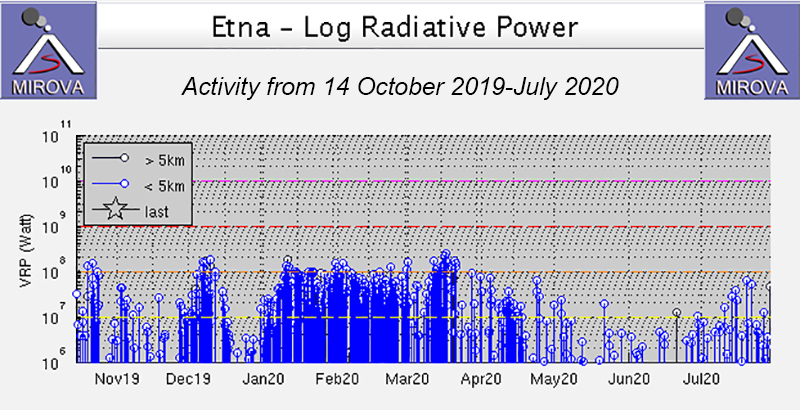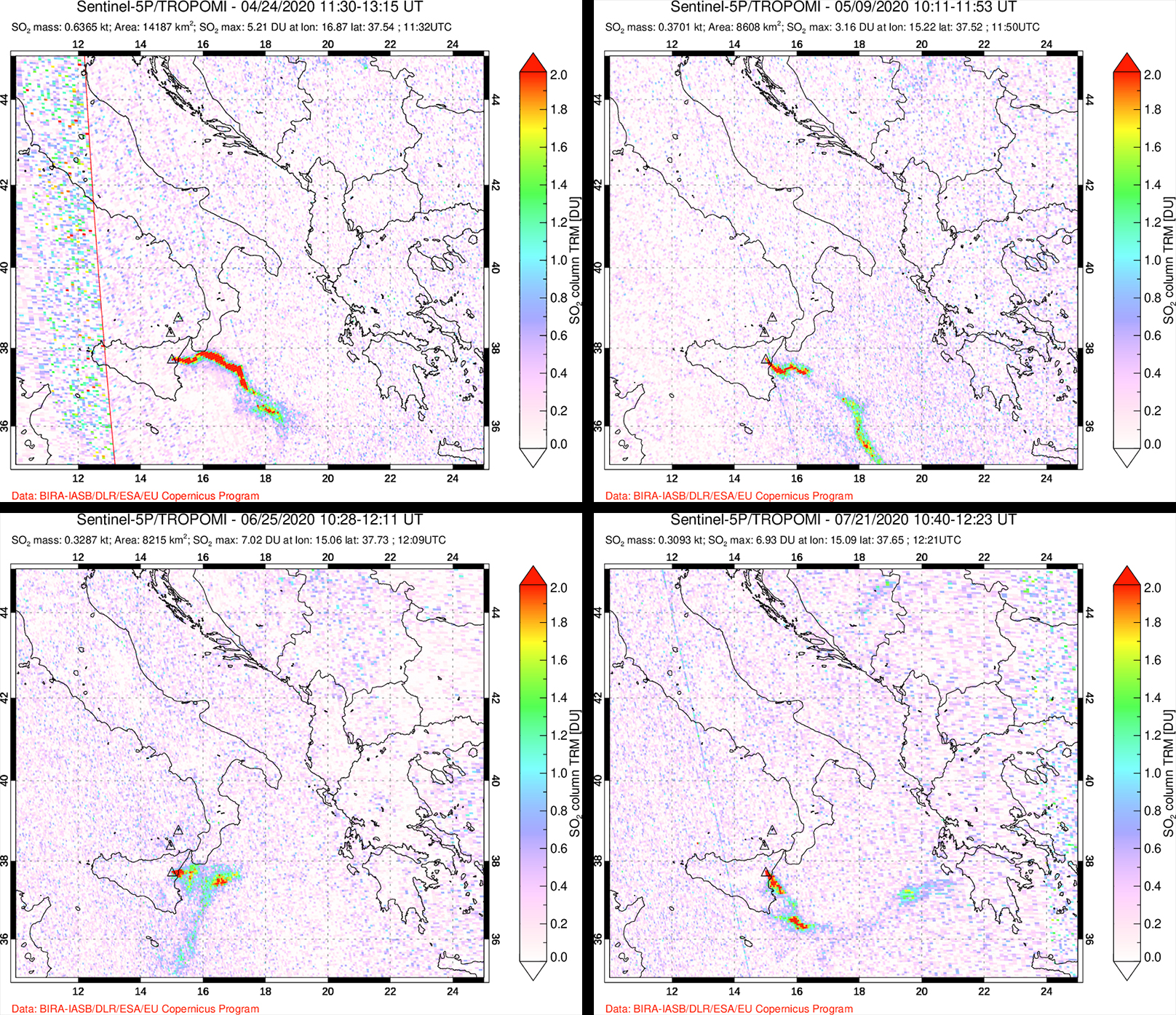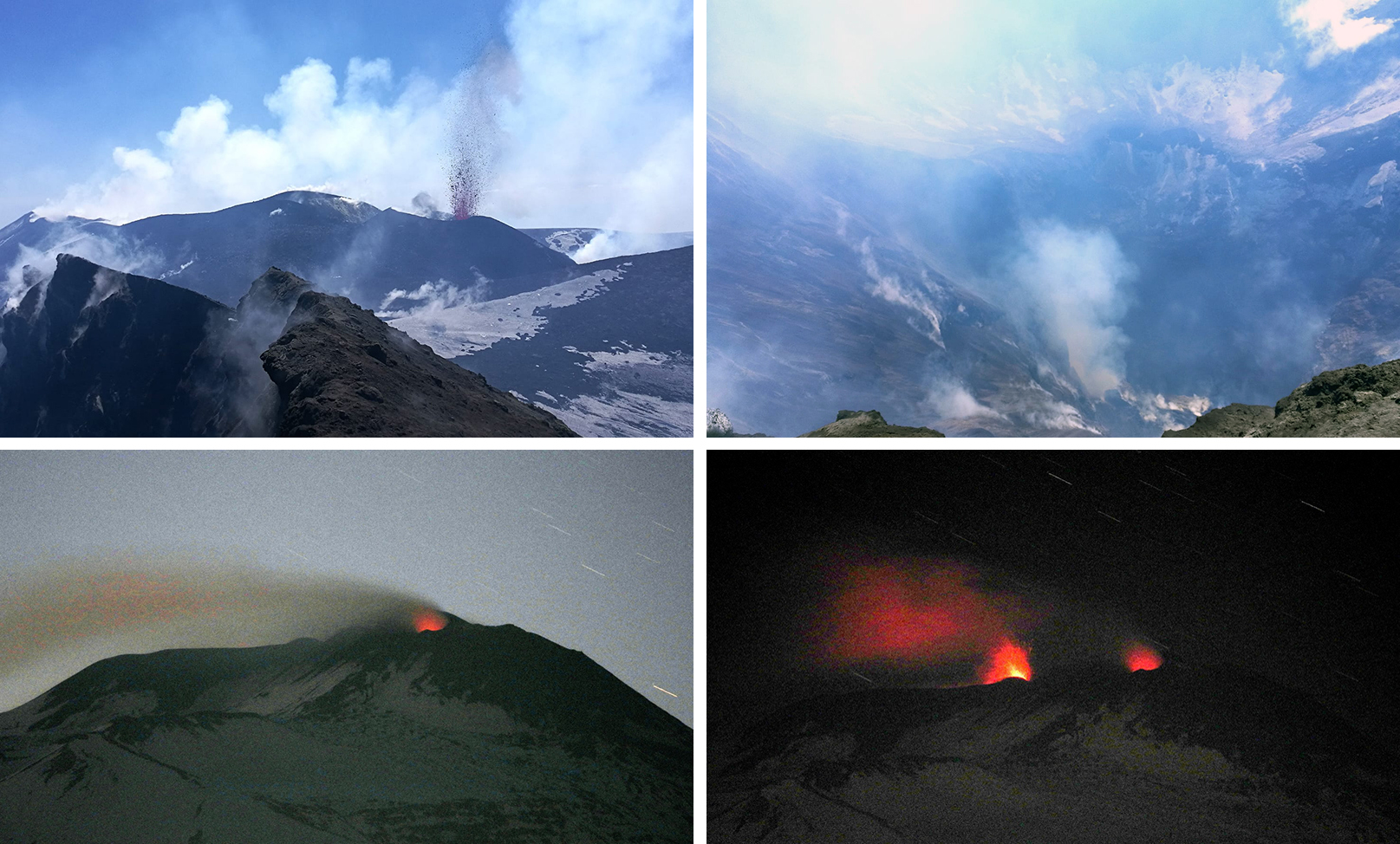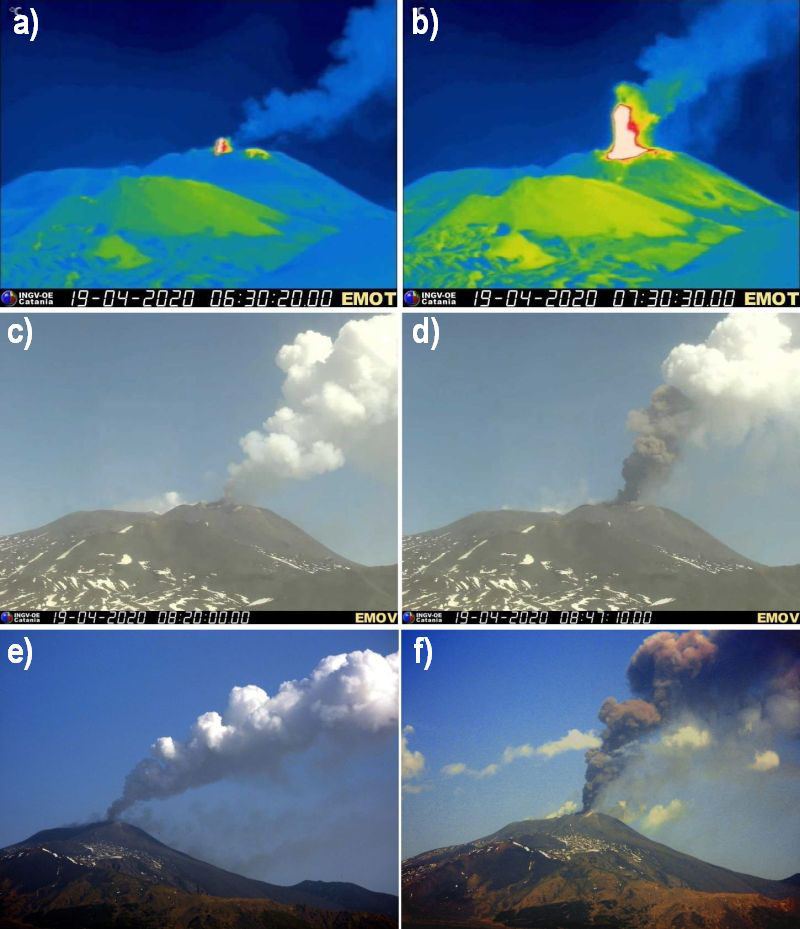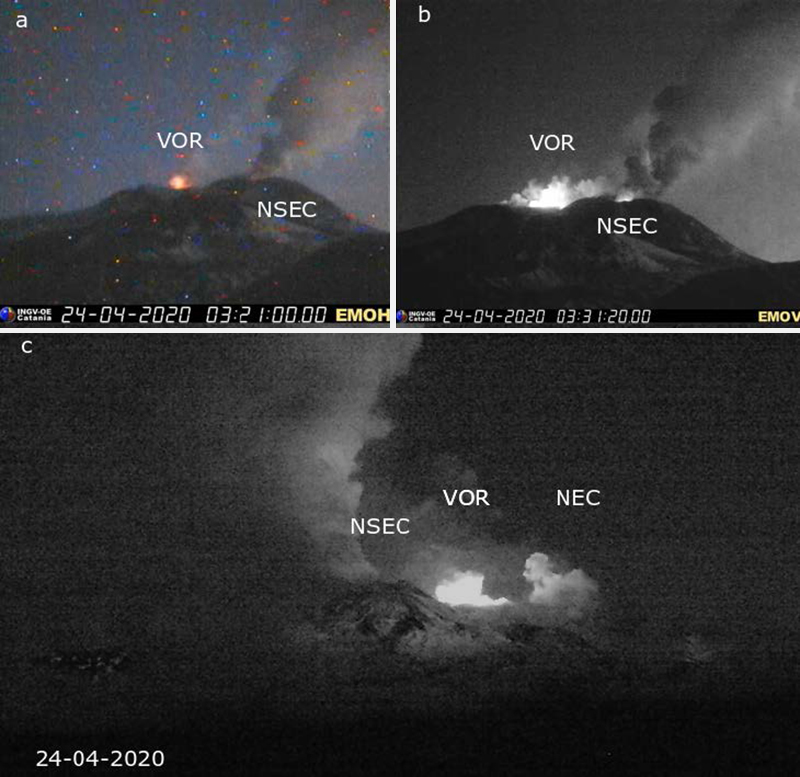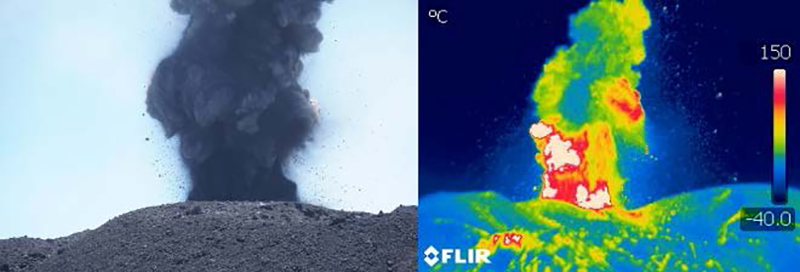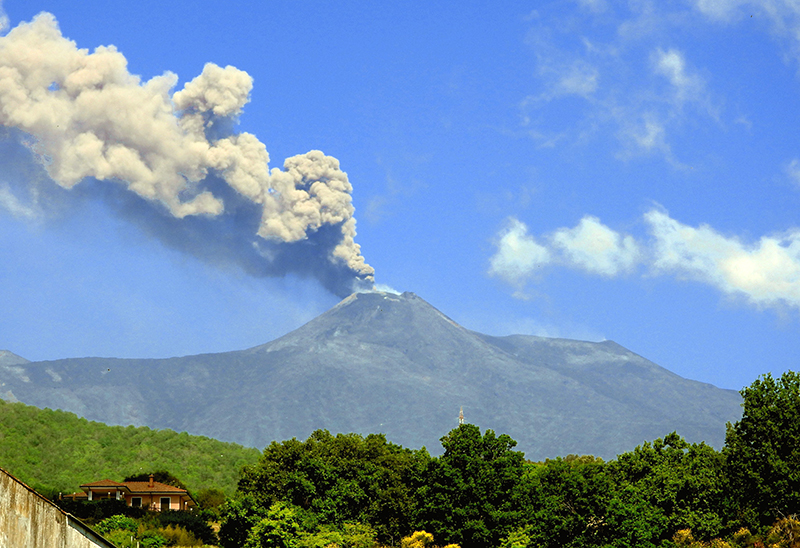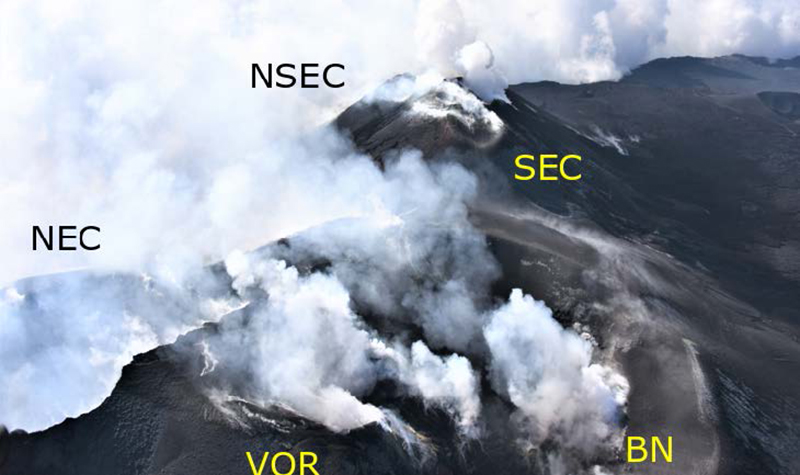Report on Etna (Italy) — September 2020
Bulletin of the Global Volcanism Network, vol. 45, no. 9 (September 2020)
Managing Editor: Edward Venzke.
Edited by Kadie L. Bennis.
Etna (Italy) Effusive activity in early April; frequent Strombolian explosions and ash emissions during April-July 2020
Please cite this report as:
Global Volcanism Program, 2020. Report on Etna (Italy) (Bennis, K.L., and Venzke, E., eds.). Bulletin of the Global Volcanism Network, 45:9. Smithsonian Institution. https://doi.org/10.5479/si.GVP.BGVN202009-211060
Etna
Italy
37.748°N, 14.999°E; summit elev. 3357 m
All times are local (unless otherwise noted)
Etna, located on the island of Sicily, Italy, is a stratovolcano that has had historical eruptions dating back 3,500 years. Its most recent eruptive period began in September 2013 and has continued through July 2020, characterized by Strombolian explosions, lava flows, and ash plumes. Activity has commonly originated from the summit areas, including the Northeast Crater (NEC), the Voragine-Bocca Nuova (or Central) complex (VOR-BN), the Southeast Crater (SEC, formed in 1978), and the New Southeast Crater (NSEC, formed in 2011). The newest crater, referred to as the "cono della sella" (saddle cone), emerged during early 2017 in the area between SEC and NSEC. Volcanism during this reporting period from April through July 2020 includes frequent Strombolian explosions primarily in the Voragine and NSEC craters, ash emissions, some lava effusions, and gas-and-steam emissions. Information primarily comes from weekly reports by the Osservatorio Etneo (OE), part of the Catania Branch of Italy's Istituo Nazionale di Geofisica e Vulcanologica (INGV).
Summary of activity during April-July 2020. Degassing of variable intensity is typical activity from all summit vents at Etna during the reporting period. Intra-crater Strombolian explosions and ash emissions that rose to a maximum altitude of 5 km on 19 April primarily originated from the Voragine (VOR) and New Southeast Crater (NSEC) craters. At night, summit crater incandescence was occasionally visible in conjunction with explosions and degassing. During 18-19 April small lava flows were observed in the VOR and NSEC craters that descended toward the BN from the VOR Crater and the upper E and S flanks of the NSEC. On 19 April a significant eruptive event began with Strombolian explosions that gradually evolved into lava fountaining activity, ejecting hot material and spatter from the NSEC. Ash plumes that were produced during this event resulted in ashfall to the E of Etna. The flows had stopped by the end of April; activity during May consisted of Strombolian explosions in both the VOR and NSEC craters and intermittent ash plumes rising 4.5 km altitude. On 22 May Strombolian explosions in the NSEC produced multiple ash plumes, which resulted in ashfall to the S. INGV reported that the pit crater at the bottom of BN had widened and was accompanied by degassing. Explosions with intermittent ash emissions continued during June and July and were primarily focused in the VOR and NSEC craters; mild Strombolian activity in the SEC was reported in mid-July.
MIROVA (Middle InfraRed Observation of Volcanic Activity) analysis of MODIS satellite data shows multiple episodes of thermal activity throughout the reporting period (figure 296). In early April, the frequency and power of the thermal anomalies began to decrease through mid-June; in July, they had increased in power again but remained less frequent compared to activity in January through March. According to the MODVOLC thermal algorithm, a total of seven alerts were detected in the summit craters during 10 April (1), 17 April (1), 24 April (2), 10 July (1), 13 July (1), and 29 July (1) 2020. These thermal hotspots were typically registered during or after a Strombolian event. Frequent Strombolian activity contributed to distinct SO2 plumes that drifted in different directions (figure 297).
Activity during April-May 2020. During April, INGV reported Strombolian explosions that produced some ash emissions and intra-crater effusive activity within the Voragine Crater (VOR) and abundant degassing from the New Southeast Crater (NSEC), Northeast Crater (NEC), and from two vents on the cono della sella (saddle cone) that were sometimes accompanied by a modest amount of ash (figure 298). At night, summit crater incandescence was observed in the cono della salla. The Strombolian activity in the VOR built intra-crater scoria cones while lava flows traveled down the S flank of the largest, main cone. On 18 April effusive activity from the main cone in the VOR Crater traveled 30 m toward the Bocca Nuova (BN) Crater; the pit crater at the bottom of the BN crater had widened compared to previous observations. A brief episode of Strombolian explosions that started around 0830 on 19 April in the NSEC gradually evolved into modest lava fountaining activity by 0915, rising to 3 km altitude and ejecting bombs up to 100 m (figure 299). A large spatter deposit was found 50 m from the vent and 3-4 small lava flows were descending the NSEC crater rim; two of these summit lava flows were observed at 1006, confined to the upper E and S flanks of the cone. Around 1030, one or two vents in the cono della sella produced a gas-and-steam and ash plume that rose 5 km altitude and drifted E, resulting in ashfall on the E flank of Etna in the Valle del Bove, as well as between the towns of Zafferana Etnea (10 km SE) and Linguaglossa (17 km NE). At night, flashes of incandescence were visible at the summit. By 1155, the lava fountaining had gradually slowed, stopping completely around 1300. The NEC continued to produce gas-and-steam emissions with some intra-crater explosive activity. During the week of 20-26 April, Strombolian activity in the VOR intra-crater scoria cone ejected pyroclastic material several hundred meters above the crater rim while the lava flows had significantly decreased, though continued to travel on the E flank of the main cone. Weak, intra-crater Strombolian activity with occasional ash emissions and nightly summit incandescence were observed in the NSEC (figure 300). By 30 April there were no longer any active lava flows; the entire flow field had begun cooling. The mass of the SO2 emissions varied in April from 5,000-15,000 tons per day.
Strombolian explosions produced periodic ash emissions and ejected mild, discontinuous incandescent material in the VOR Crater; the coarse material was deposited onto the S flank of BN (figure 301). Pulsating degassing continued from the summit craters, some of which were accompanied by incandescent flashes at night. The Strombolian activity in the cono della sella occasionally produced reddish ash during 3-4 May. During 5 and 8 May, there was an increase in ash emissions at the NSEC that drifted SSE. A strong explosive event in the VOR Crater located E of the main cone produced a significant amount of ash and ejected coarse material, which included blocks and bombs measuring 15-20 cm, that fell on the W edge of the crater, as well as on the S terrace of the BN Crater (figure 302).
On 10 May degassing continued in the NSEC while Strombolian activity fluctuated in both the VOR and NSEC Craters, ejecting ballistics beyond the crater rim; in the latter, some of the blocks fell back in, accumulated on the edge, and rolled down the slopes (figure 303). During the week of 11-17 May, eruptive activity at the VOR Crater was the lowest observed since early March; there were 4-5 weak, low intensity pulses not accompanied by bombs or ashfall in the VOR Crater. Degassing continued in the BN Crater. The crater of the cono della sella had widened further N following collapses due to the Strombolian activity, which exposed the internal wall.
On 18 May an ash plume from the NSEC rose 4.5 km altitude and drifted NE. Strombolian explosions on 22 May at the NSEC produced multiple ash plumes that rose 4.5 km altitude and drifted S and SW (figure 304), depositing a thin layer of ash on the S slope, and resulting in ashfall in Catania (27 km S). Explosions from the VOR Crater had ejected a deposit of large clasts (greater than 30 cm) on the NE flank, between the VOR Crater and NEC on 23 May. INGV reported that the pit crater in the BN continued to widen and degassing was observed in the NSEC, VOR Crater, and NEC. During the week of 25-31 May persistent visible flashes of incandescence at night were observed, which suggested there was intra-crater Strombolian activity in the SEC and NSEC. The mass of the SO2 plumes varied between 5,000-9,000 tons per day.
Activity during June-July 2020. During June, moderate intra-crater Strombolian activity with intermittent ash emissions continued in the NSEC and occurred more sporadically in the VOR Crater; at night, incandescence of variable intensity was observed at the summit. During the week of 8-14 June, Strombolian explosions in the cono della sella generated some incandescence and rare jets of incandescent material above the crater rim, though no ash emissions were reported. On the morning of 14 June a sequence of ten small explosions in the VOR Crater ejected incandescent material just above the crater rim and produced small ash emissions. On 25 June an overflight showed the developing pit crater in the center of the BN, accompanied by degassing along the S edge of the wall; degassing continued from the NEC, VOR Crater, SEC, and NSEC (figure 305). The mass of the SO2 plumes measured 5,000-7,000 tons per day, according to INGV.
Similar modest, intra-crater Strombolian explosions in the NSEC, sporadic explosions in the VOR Crater, and degassing in the BN, VOR Crater, and NEC persisted into July. On 2 July degassing in the NEC was accompanied by weak intra-crater Strombolian activity. Intermittent weak ash emissions and ejecta from the NSEC and VOR Crater were observed during the month. During the week of 6-12 July INGV reported gas-and-steam emissions continued to rise from the vent in the pit crater at the bottom of BN (figure 306). On 11 July mild Strombolian activity, nighttime incandescence, and degassing was visible in the SEC (figure 307). By 15 July there was a modest increase in activity in the NSEC and VOR Craters, generating ash emissions and ejecting material over the crater rims while the other summit craters were dominantly characterized by degassing. On 31 July an explosion in the NSEC produced an ash plume that rose 4.5 km altitude.
Geological Summary. Mount Etna, towering above Catania on the island of Sicily, has one of the world's longest documented records of volcanism, dating back to 1500 BCE. Historical lava flows of basaltic composition cover much of the surface of this massive volcano, whose edifice is the highest and most voluminous in Italy. The Mongibello stratovolcano, truncated by several small calderas, was constructed during the late Pleistocene and Holocene over an older shield volcano. The most prominent morphological feature of Etna is the Valle del Bove, a 5 x 10 km caldera open to the east. Two styles of eruptive activity typically occur, sometimes simultaneously. Persistent explosive eruptions, sometimes with minor lava emissions, take place from one or more summit craters. Flank vents, typically with higher effusion rates, are less frequently active and originate from fissures that open progressively downward from near the summit (usually accompanied by Strombolian eruptions at the upper end). Cinder cones are commonly constructed over the vents of lower-flank lava flows. Lava flows extend to the foot of the volcano on all sides and have reached the sea over a broad area on the SE flank.
Information Contacts: Sezione di Catania - Osservatorio Etneo, Istituto Nazionale di Geofisica e Vulcanologia (INGV), Sezione di Catania, Piazza Roma 2, 95123 Catania, Italy (URL: http://www.ct.ingv.it/it/); MIROVA (Middle InfraRed Observation of Volcanic Activity), a collaborative project between the Universities of Turin and Florence (Italy) supported by the Centre for Volcanic Risk of the Italian Civil Protection Department (URL: http://www.mirovaweb.it/); Hawai'i Institute of Geophysics and Planetology (HIGP) - MODVOLC Thermal Alerts System, School of Ocean and Earth Science and Technology (SOEST), Univ. of Hawai'i, 2525 Correa Road, Honolulu, HI 96822, USA (URL: http://modis.higp.hawaii.edu/); Global Sulfur Dioxide Monitoring Page, Atmospheric Chemistry and Dynamics Laboratory, NASA Goddard Space Flight Center (NASA/GSFC), 8800 Greenbelt Road, Goddard, Maryland, USA (URL: https://so2.gsfc.nasa.gov/); Boris Behncke, Istituto Nazionale di Geofisica e Vulcanologia (INGV), Sezione di Catania, Piazza Roma 2, 95123 Catania, Italy.


